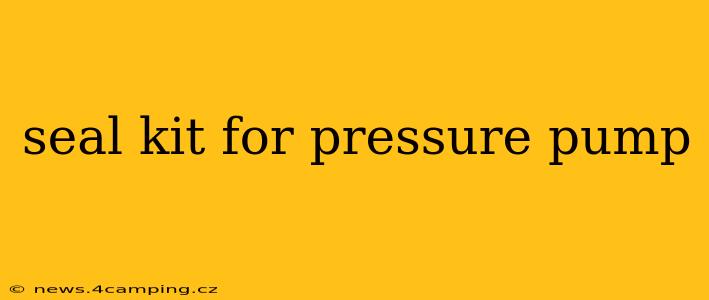Pressure pumps, vital components in various industries, rely heavily on effective sealing to maintain performance and prevent leaks. A failing seal can lead to significant downtime, costly repairs, and even safety hazards. Understanding seal kits for pressure pumps, their types, selection, and installation, is crucial for maintaining optimal pump operation. This guide delves into the intricacies of pressure pump seal kits, providing you with the knowledge to make informed decisions and ensure your pumps run smoothly.
What is a Pressure Pump Seal Kit?
A pressure pump seal kit is a collection of replacement seals and related components designed to restore the sealing integrity of a pressure pump. These kits typically include various seals—like O-rings, lip seals, and mechanical seals—along with other parts such as gaskets, springs, and retaining rings. The specific contents vary depending on the pump's make, model, and the type of seal system used. Choosing the right kit is paramount; using an incorrect one can exacerbate problems or even damage the pump.
What are the Different Types of Seals Used in Pressure Pumps?
Several types of seals are commonly employed in pressure pumps, each suited for specific applications and pressures:
-
O-rings: These simple, versatile seals are widely used for static and dynamic sealing applications. They are cost-effective and readily available but may not be suitable for high-pressure or high-temperature applications.
-
Lip Seals (Radial Shaft Seals): These seals are designed to prevent leakage between a rotating shaft and a stationary housing. They are effective for moderate pressures and speeds and are commonly found in many types of pumps.
-
Mechanical Seals: These seals are the most sophisticated type, designed for high-pressure, high-temperature, and high-speed applications. They consist of stationary and rotating faces that create a leak-proof barrier. Mechanical seals require precise installation and maintenance.
How to Choose the Right Seal Kit for Your Pressure Pump?
Selecting the appropriate seal kit requires careful attention to detail:
-
Identify the Pump Manufacturer and Model: This information is crucial to ensure compatibility. The manufacturer's documentation or the pump's identification plate should provide this information.
-
Determine the Type of Seal: Knowing the type of seal currently used in your pump (O-ring, lip seal, or mechanical seal) is vital for choosing the right replacement kit.
-
Check the Pressure and Temperature Ratings: The seal kit must be rated for the operating pressure and temperature conditions of your pump to ensure reliable performance and prevent failure.
-
Consider the Pump Fluid: The compatibility of the seal material with the pumped fluid is critical. Using an incompatible seal can lead to seal degradation and leakage.
-
Source the Kit from a Reputable Supplier: Purchase seal kits from reputable suppliers who can guarantee authenticity and quality.
How Often Should I Replace My Pressure Pump Seal Kit?
The frequency of seal kit replacement depends on various factors, including:
- Pump operating hours: Regular use naturally wears seals.
- Operating pressure and temperature: High pressure and temperature accelerate seal degradation.
- Fluid compatibility: Incompatible fluids can quickly degrade seals.
- Maintenance practices: Regular inspection and lubrication can prolong seal life.
It's best to consult your pump's operating manual for recommended replacement intervals. Regular inspections for leaks and signs of wear are essential to prevent unexpected failures.
What are the Signs that My Pressure Pump Needs a New Seal Kit?
Several signs indicate that your pressure pump seal kit may be failing:
- Leaks: Visible leaks around the pump shaft or casing are the most obvious sign of a seal problem.
- Reduced pressure: A decline in pump pressure may indicate a seal leak.
- Unusual noises: Unusual noises or vibrations from the pump may suggest seal wear or damage.
- Fluid contamination: If the pumped fluid is being contaminated, a seal leak might be the cause.
Can I Install a Pressure Pump Seal Kit Myself?
While some simpler seal kits might be manageable for DIY enthusiasts with mechanical aptitude, installing more complex kits, especially mechanical seals, often requires specialized tools and expertise. Incorrect installation can damage the pump or lead to improper sealing. For complex kits or if you're unsure, it's always best to consult a qualified technician or pump specialist.
Where Can I Find a Seal Kit for My Pressure Pump?
Seal kits can usually be purchased from pump manufacturers, specialized pump repair shops, or online industrial supply retailers. Always ensure the kit you purchase matches your pump's specifications precisely.
By following this guide and understanding the nuances of pressure pump seal kits, you can ensure the longevity and efficient operation of your pressure pumps, minimizing downtime and maximizing productivity. Remember, prevention is key, and regular inspection and timely maintenance are crucial for avoiding costly repairs.
